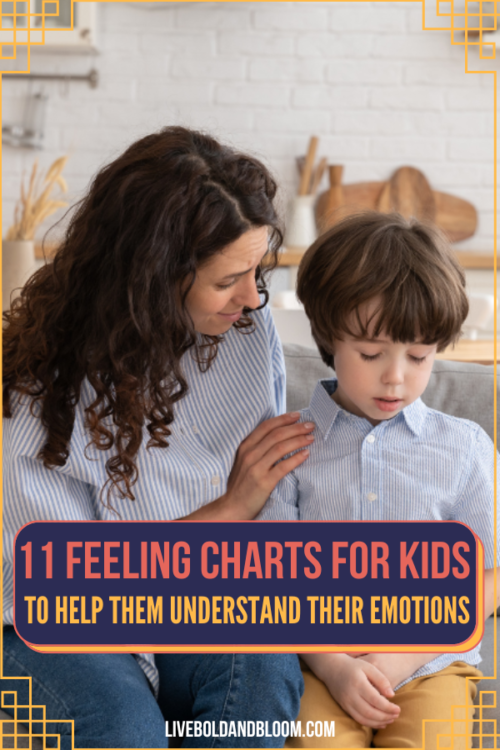Are your kids feeling overwhelmed with their emotions?
Are they struggling to understand and express how they feel?
As kids grow, it’s essential to help them explore their emotions, learn about their feelings, and communicate them effectively.
And that’s precisely where feelings charts for kids come in!
These mood charts are excellent for nurturing emotional intelligence to support your child’s emotional development.
Are you ready to help your child identify and manage their feelings in a fun and creative way?
Then read on below: printable feelings charts for kids.
How Do You Use an Emotions Chart for Kids?
Purchasing a mood chart for kids isn’t enough if you don’t know how to use it.
You still need to create an environment where your child feels comfortable discussing their emotions and accurately using the printable feelings chart.
Here are a few tips to ensure you get the most out of your printable feelings charts for kids:
- Sit down with your child and go through each emotion on the chart individually, asking them to explain each emotion and how it makes them feel.
- Let them know it’s ok to feel a wide range of emotions(especially the negative ones) and that it doesn’t mean there’s something wrong with them!
- When your kids can identify their feelings on the chart, help them devise solutions for how they can express or manage those emotions.
- If your kids still have difficulty understanding their emotions, you can use kids’ pictures to show them the feeling they are experiencing.
- Use the pictures and emojis on the chart to build your kid’s vocabulary, helping them know how to name and express their feelings.
11 Fun and Useful Feelings Charts for Kids
Now that you know how to use an emotion chart for kids, let’s look at some examples!
Here are 11 kids’ feelings chart ideas that you can use to help children understand and manage their emotions better:
1. Hope 4 Hurting Kids Emotions Chart
Hope 4 Hurting Kids is an organization that provides resources to those caring for children who have experienced trauma.
To help these children recover, the group created an emotion chart that allows them to identify and name their feelings.
This chart can be used by educators, therapists, parents, and other caregivers as it encourages self-awareness for the child.
Hope 4 Hurting Kids aims to give children the knowledge and tools to work through their difficult emotions and ultimately heal from their trauma.
You can download the entire chart here.
2. Osmo Feelings Chart For Kids
This fun and interactive kids’ feelings chart from Osmo is designed for kids ages 3-8. Not only does it help them become more aware of their emotions, but it also helps them identify why they are feeling that way.
The chart is like a game, with emojis that kids can mark on the board to start conversations about their feelings. Your kids can also write and draw on the board to explain their feelings in more detail, providing a fun and easy way for them to express themselves.
Get the three-part kids’ feelings chart here.
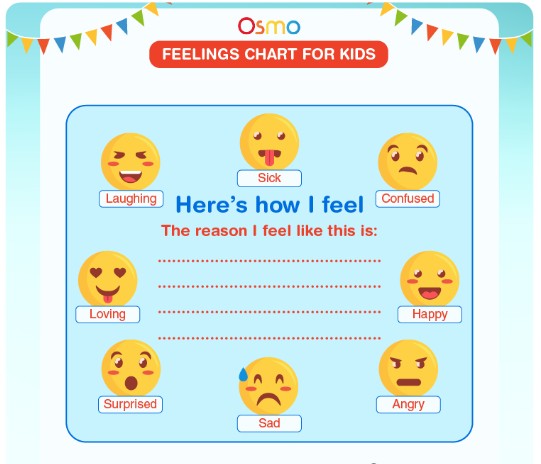
3. BrainFrame Emotion Wheel for Older Kids
BrainFrame is an emotion wheel designed for older kids. It’s the perfect way to help your child better understand and manage their emotions in a fun, interactive way!
The wheel is also designed to help kids positively express their emotions. It encourages kids to recognize the range of feelings they may experience, from fear and anger to happiness and sadness, and how they express these emotions.
For instance, if your child feels fearful, it might manifest as anxiety, insecurity, and feelings of powerlessness.
Through the wheel, they can explore and discuss these feelings in a safe space while gaining the skills to express their emotions and manage them better.
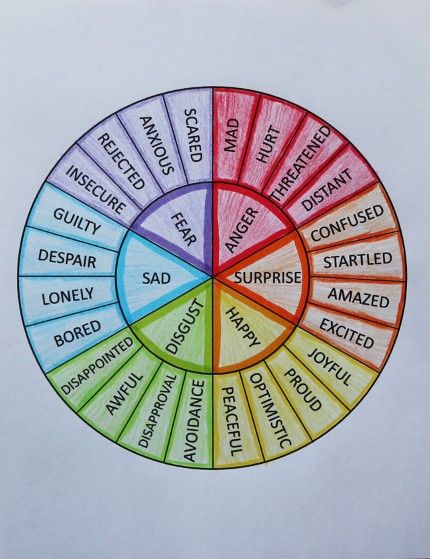
4. Mindful Little Feelings Chart
The Mindful Little Feelings Chart is a fantastic tool for helping children identify and express their emotions. It’s perfect for teaching kids how to recognize and label their feelings, which is the first step in building emotional intelligence.
With this chart, kids can simply point to the chart to share their feelings instead of talking when they’re too overwhelmed to do so.
It also helps them develop empathy by teaching them the physical signs of different emotions and how they look in others.
With this chart, kids will be able to respond to others with understanding and kindness while learning necessary social skills.
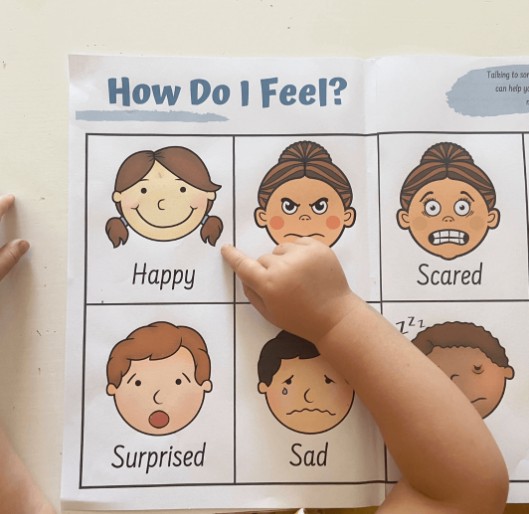
5. Fun With Mama Feelings Chart For Kids
Are you looking for something to teach your little kids about their emotions? Look no further! This character emotion chart is the perfect way to help young children, especially pre-schoolers, understand their feelings.
With a printable black-and-white version and a color option, this chart can be used in any setting – from classrooms to homes.
From frustration to positive feelings and everything in between, this chart helps your kids find the right word for their emotions.
You can use the chart to teach your kids emotional literacy and expand their vocabulary, so they can effectively express their feelings.
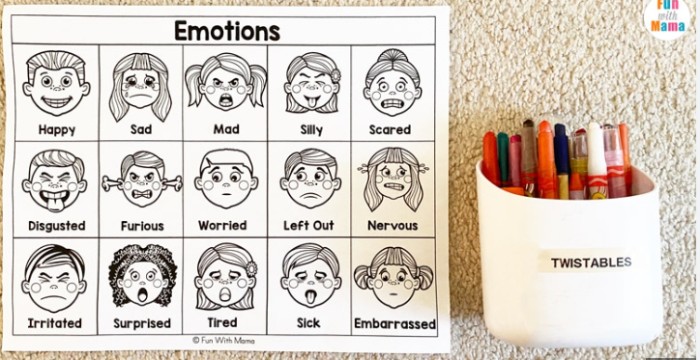
More Related Articles
58 Fun Facts About Yourself That Everyone Wants To Hear
Tune In To Your Emotions With These 15 Feelings Charts For Adults (Printables)
17 Sweet Poems That Remind You What Growing Up Is All About
6. Pure Wow How Are You Feeling Today?
This is the perfect emotion chart for preschoolers, packed with fun and colorful illustrations, showing the different feelings that children can experience.
This chart helps children recognize and name their emotions, an essential skill for kids to learn at a young age. It features sixteen different emotions with facial illustrations to match and is perfect for your child’s inability to articulate their feelings.
It’s a great tool to help kids become more aware of their feelings and develop the language they need to share them with others.
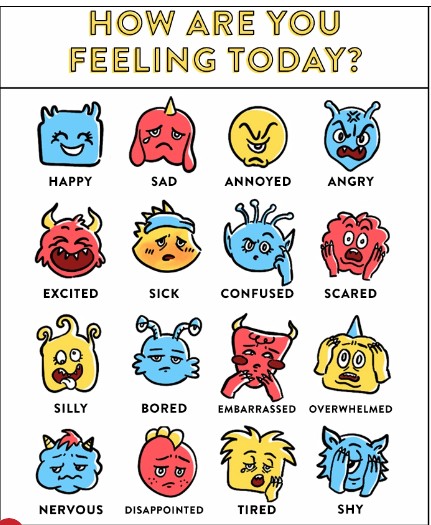
7. Hi Mama Printable Kids’ Calming Corner Chart
Do you know that more kids today cannot express their emotions productively and healthily? This is often seen in adulthood and adolescence when young people struggle to understand or manage their feelings.
That’s why it’s essential to introduce emotional intelligence skills early on. And what a great way to do this than with a Hi Mama Printable Kids’ Calming Corner Chart. This chart can help your kids take ownership of their feelings in an age-appropriate manner.
You can use the chart as part of a designated comfy or calm corner where your children often get away when things are too overwhelming.

8. Printable Emotion Mood Face Chart
This emotional mood face chart features different-colored emojis representing the different emotions we feel every day.
From excitement and happiness to anger and sadness, this chart will help your preschooler articulate how they are feeling, helping them better understand themselves and the people around them.
This chart is a great visual aid that will encourage your child to connect words with their feelings, leading to healthier communication in the future!
It also serves as an excellent conversation starter for parents and teachers about managing different emotions, especially when things don’t go according to plan.
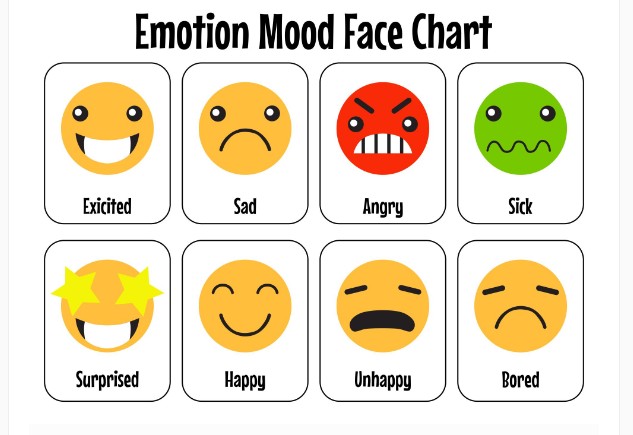
9. Carson Dellosa Emotion Chart Grade PK2
Teaching kids about emotions doesn’t have to be boring! Fortunately, this Carson Dellosa Emotion Chart is the perfect tool to help young learners recognize and express their feelings in the classroom.
With 16 different emotions, each represented by a picture of a child expressing that emotion, this chart can be invaluable in teaching kids the value of nonverbal communication.
Whether it’s used as part of early learning, for special needs, or to reinforce concepts, this chart provides an excellent way for teachers, students, parents, and kids to interact.
And with other Carson-Dellosa charts available, you can create a fun and informative environment for your child for $3.99 per chart.
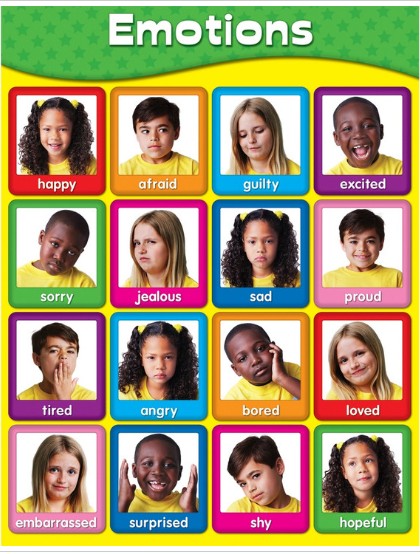
10. Kimochis Feeling Detective Charts
Of course, this list wouldn’t be complete without including the Kimochis charts. These printable charts will help your child explore their feelings and develop different coping strategies.
Each chart features Kimochi characters that you can use to help your child express the various emotions they are feeling.
What’s more, these charts come in all major languages, from English and Spanish to Japanese and Korean, making them perfect for bilingual kids.
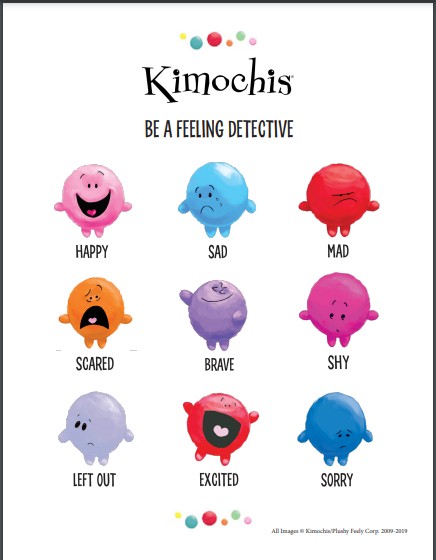
11. Reward Charts 4 Kids Emotional Thermometer
This emotional thermometer is the perfect printable chart for your kid’s bedroom. The icon-style chart features a range of temperatures from hot to cold, representing the different emotions felt throughout the day.
Reward Charts 4 Kids also offers parents blank PDF charts, which are typable to help create a custom chart that fits your child’s interests and needs.
You can also add some strategies to help your child cope with their emotions based on their age, needs, and situation.

Get an Emotional Chart for Your Child Now
Emotional intelligence is an important skill to teach children at a young age. With the right tools, kids can develop their emotional literacy and learn how to communicate their emotions effectively.
Plenty of kids’ emotion chart activities are available to help children recognize, process, and express their feelings. No matter which tool you choose, it will be an excellent way for your child to learn about emotions in a safe and fun space.
